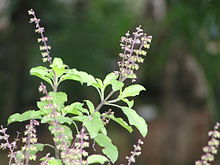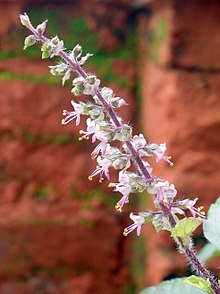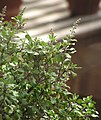bio.wikisort.org - Plant
Ocimum tenuiflorum, commonly known as holy basil, tulsi or tulasi,[2] is an aromatic perennial plant in the family Lamiaceae. It is native to the Indian subcontinent and widespread as a cultivated plant throughout the Southeast Asian tropics.[3][4]
| Ocimum tenuiflorum | |
|---|---|
 | |
| Scientific classification | |
| Kingdom: | Plantae |
| Clade: | Tracheophytes |
| Clade: | Angiosperms |
| Clade: | Eudicots |
| Clade: | Asterids |
| Order: | Lamiales |
| Family: | Lamiaceae |
| Genus: | Ocimum |
| Species: | O. tenuiflorum |
| Binomial name | |
| Ocimum tenuiflorum L. | |
| Synonyms[1] | |
| |
Tulsi is cultivated for religious and traditional medicine purposes, and also for its essential oil. It is widely used as a herbal tea, commonly used in Ayurveda, and has a place within the Vaishnava tradition of Hinduism, in which devotees perform worship involving holy basil plants or leaves.
The variety of Ocimum tenuiflorum used in Thai cuisine is referred to as Thai holy basil (Thai: กะเพรา kaphrao) and is the key herb in phat kaphrao, a stir-fry dish;[3] it is not the same as Thai basil, which is a variety of Ocimum basilicum. In Cambodia, it is known as mreah-prov (Khmer: ម្រះព្រៅ[5]).
Morphology


Holy basil is an erect, many-branched subshrub, 30–60 cm (12–24 in) tall with hairy stems. Leaves are green or purple; they are simple, petioled, with an ovate blade up to 5 cm (2 in) long, which usually has a slightly toothed margin; they are strongly scented and have a decussate phyllotaxy. The purplish flowers are placed in close whorls on elongated racemes.[4]
The three main morphotypes cultivated in India and Nepal are Ram tulsi (the most common type, with broad bright green leaves that are slightly sweet), the less common purplish green-leaved (Krishna or Shyam tulsi) and the common wild vana tulsi (e.g., Ocimum gratissimum).[6]
Origin and distribution
DNA barcodes of various biogeographical isolates of tulsi from the Indian subcontinent are now available. In a large-scale phylogeographical study of this species conducted using chloroplast genome sequences, a group of researchers from Central University of Punjab, Bathinda, have found that this plant originates from North-Central India.[7]
This basil has now escaped from cultivation and has naturalised into a cosmopolitan distribution.[8][9]
Chemical composition
Some of the phytochemical constituents of tulsi are oleanolic acid, ursolic acid, rosmarinic acid, eugenol, carvacrol, linalool, and β-caryophyllene (about 8%).[10]
Tulsi essential oil consists mostly of eugenol (~70%) β-elemene (~11.0%), β-caryophyllene (~8%), and germacrene (~2%), with the balance being made up of various trace compounds, mostly terpenes.[11]
Genome sequence
The genome of the tulsi plant has been sequenced and reported as a draft, estimated to be 612 mega bases, with results showing genes for biosynthesis of anthocyanins in Shyama Tulsi, ursolic acid and eugenol in Rama Tulsi.[12][13] The predicted proteins and other annotations are available[13] from caps.ncbs.res.in/Ote.
Uses
Tulsi (Sanskrit: Surasa) has been used in Ayurvedic and Siddha practices for its supposed treatment of diseases.[14][15]
Insect repellent
For centuries, the dried leaves have been mixed with stored grains to repel insects.[16]
Nematicidal
The essential oil may have nematicidal properties against Tylenchulus semipenetrans, Meloidogyne javanica, Anguina tritici, and Heterodera cajani.[17]
Disinfection
Water disinfection using O. tenuiflorum extracts was tested by Bhattacharjee et al 2013 and Sadul et al 2009. Both found an alcoholic extract to be more effective than aqueous or leaf juice. Sundaramurthi et al 2012 finds the result to be safe to drink, and additionally to be antimicrobial. A constituent analysis by Sadul found alkaloids, steroids, and tannins in the aqueous, and alkaloids and steroids only in the alcoholic extract.[18]
Significance in Hinduism
Tulsi is a sacred plant for Hindus, particularly the Vaishnavite sect. It is worshipped as the avatar of Lakshmi,[citation needed] and may be planted in courtyards of Hindu houses or Hanuman temples.[19] The ritual lighting of lamps each evening during Kartik includes the worship of the tulsi plant.[20][21] Vaishnavas followers of Vishnu are known as "those who bear the tulsi around the neck".[19]
Tulsi Vivah is a ceremonial festival performed between Prabodhini Ekadashi (the 11th or 12th lunar day of the bright fortnight of the Hindu month of Kartik) and Kartik Purnima (the full moon of the month).[22][23]
On every evening Bengali Hindus place earthen lamps in font of tulsi plants. In the Kati Bihu festival celebrated in Assam, people light earthen lamps (diya) at the foot of the household tulasi plants and pray.[24]
In popular culture
Tulsi has been the subject of some hit Indian films. Main among these are 1971 Bollywood fantasy drama film Tulsi Vivah (The Marriage Of Tulsi) and 1978 Indian "Super Hit" film Main Tulsi Tere Aangan Ki (I Am The Tulsi Of Your Courtyard).
Gallery
- On Deccan Plateau, India
- Leaves and flowers
- In a home garden
- Leaves
- Inflorescence
 Flower
Flower- Flowers
- Altar with tulsi plant for daily worship in a courtyard
- Prayer beads made from tulsi wood
- Plant shrub
- At night
See also
- Sacred trees
- Sacred groves
References
- "The Plant List: A Working List of All Plant Species". Retrieved 13 January 2015.
- "Ocimum tenuiflorum". Germplasm Resources Information Network (GRIN). Agricultural Research Service (ARS), United States Department of Agriculture (USDA). Retrieved 7 July 2021.
- Staples, George; Michael S. Kristiansen (1999). Ethnic Culinary Herbs. University of Hawaii Press. p. 73. ISBN 978-0-8248-2094-7.
- Warrier, P K (1995). Indian Medicinal Plants. Orient Longman. p. 168. ISBN 978-0-86311-551-6.
- "Ocimum tenuiflorum". Global Biodiversity Information Facility. Retrieved 2 October 2022.
- Kothari, S. K.; Bhattacharya, A. K.; Ramesh, S.; Garg, S. N.; Khanuja, S. P. S. (November–December 2005). "Volatile Constituents in Oil from Different Plant Parts of Methyl Eugenol-Rich Ocimum tenuiflorum L.f. (syn. O. sanctum L.) Grown in South India". Journal of Essential Oil Research. 17 (6): 656–658. doi:10.1080/10412905.2005.9699025. S2CID 95551382.
- Bast, Felix; Pooja Rani; Devendra Meena (2014). "Chloroplast DNA Phylogeography of Holy Basil (Ocimum tenuiflorum) in Indian Subcontinent". The Scientific World Journal. 70 (3): 277–85. doi:10.1155/2014/847482. PMC 3910118. PMID 847482.
- "Ocimum tenuiflorum (holy basil) - CABI Invasive Species Compendium".
- "ITIS Standard Report Page: Ocimum tenuiflorum".
- Sundaram, R. Shanmuga; Ramanathan, M; Rajesh, R; Satheesh, B; Saravanan, D (2012). "Lc-Ms Quantification of Rosmarinic Acid and Ursolic Acid in Theocimum Sanctumlinn. Leaf Extract (Holy Basil, Tulsi)". Journal of Liquid Chromatography & Related Technologies. 35 (5): 634. doi:10.1080/10826076.2011.606583. S2CID 95225535.
- Padalia, Rajendra C.; Verma, Ram S. (2011). "Comparative volatile oil composition of four Ocimum species from northern India". Natural Product Research. 25 (6): 569–575. doi:10.1080/14786419.2010.482936. PMID 21409717. S2CID 205836713.
- Upadhyay, Atul K.; Chacko, Anita R.; Gandhimathi, A.; Ghosh, Pritha; Harini, K.; Joseph, Agnel P.; Joshi, Adwait G.; Karpe, Snehal D.; Kaushik, Swati; Kuravadi, Nagesh; Lingu, Chandana S; Mahita, J.; Malarini, Ramya; Malhotra, Sony; Malini, Manoharan; Mathew, Oommen K.; Mutt, Eshita; Naika, Mahantesha; Nitish, Sathyanarayanan; Pasha, Shaik Naseer; Raghavender, Upadhyayula S.; Rajamani, Anantharamanan; Shilpa, S; Shingate, Prashant N.; Singh, Heikham Russiachand; Sukhwal, Anshul; Sunitha, Margaret S.; Sumathi, Manojkumar; Ramaswamy, S.; Gowda, Malali; Sowdhamini, Ramanathan (28 August 2015). "Genome sequencing of herb Tulsi (Ocimum tenuiflorum) unravels key genes behind its strong medicinal properties". BMC Plant Biology. 15 (1): 212. doi:10.1186/s12870-015-0562-x. PMC 4552454. PMID 26315624.
- Chen, Fei; Song, Yunfeng; Li, Xiaojiang; Chen, Junhao; Mo, Lan; Zhang, Xingtan; Lin, Zhenguo; Zhang, Liangsheng (2019-10-08). "Genome sequences of horticultural plants: past, present, and future". Horticulture Research. Nature + Nanjing Agricultural University. 6 (1): 1–23. doi:10.1038/s41438-019-0195-6. ISSN 2662-6810. PMC 6804536. PMID 31645966.
- NIIR Board, National Institute of Industrial Research (India) (2004). Compendium of Medicinal Plants. 2004. National Institute of Industrial Research. p. 320. ISBN 978-81-86623-80-0.
- Lesley Braun; Marc Cohen (30 March 2015). Herbs and Natural Supplements, Volume 2: An Evidence-Based Guide. Elsevier Health Sciences. p. 996. ISBN 978-0-7295-8173-8.
- Biswas, N. P.; Biswas, A. K. (2005). "Evaluation of some leaf dusts as grain protectant against rice weevil Sitophilus oryzae (Linn.)". Environment and Ecology. 23 (3): 485–488.
- Chitwood, David J. (2002). "Phytochemical Based Strategies for Nematode Control". Annual Review of Phytopathology. Annual Reviews. 40 (1): 221–249. doi:10.1146/annurev.phyto.40.032602.130045. ISSN 0066-4286. PMID 12147760.
- Pandit, Aniruddha B.; Kumar, Jyoti Kishen (2015-07-24). "Clean Water for Developing Countries". Annual Review of Chemical and Biomolecular Engineering. Annual Reviews. 6 (1): 217–246. doi:10.1146/annurev-chembioeng-061114-123432. ISSN 1947-5438. PMID 26247291.
- Simoons, Frederick J. (1998). Plants of life, plants of death. Univ of Wisconsin Press. pp. 7–40. ISBN 978-0-299-15904-7.
- Flood, Gavin D. (2001). The Blackwell companion to Hinduism. Wiley-Blackwell. p. 331. ISBN 978-0-631-21535-6.
- Wilkins, W.J. (2003). Hindu Mythology. New Delhi: D.K. Printworld. p. 471. ISBN 978-81-246-0234-8.
- Underhill, M. M. (1991). The Hindu Religious Year. Asian Educational Services. pp. 129–131. ISBN 978-81-206-0523-7.
- Pawar, Shubhangi; Patil, D. A. (2008). Ethnobotany of Jalgaon District, Maharashtra. Daya Publishing House. p. 400. ISBN 978-81-7035-515-1.
- ANI. "Kati Bihu celebrated in Assam". BW Businessworld. Retrieved 2022-06-09.
External links
![]() Media related to Ocimum tenuiflorum at Wikimedia Commons
Media related to Ocimum tenuiflorum at Wikimedia Commons
На других языках
- [en] Ocimum tenuiflorum
[es] Ocimum tenuiflorum
Ocimum tenuiflorum, nombre común albahaca morada,[1] es una planta aromática de la familia de las lamiáceas, considerada sagrada por el hinduismo. Es pariente cercana de la albahaca común Ocimum basilicum. En Filipinas se llama balanoi.[2][ru] Туласи
Туласи (санскр. तुलसी, IAST: tulasī), или Базили́к тонкоцве́тный (лат. Ocimum tenuiflorum), или Базилик свяще́нный (лат. Ocimum sanctum) — кустарник семейства Яснотковые (лат. Lamiaceae). Широко используется в кулинарии (встречается калька с англоязычного «тулси») и в лечебных целях, в особенности в аюрведической медицине. Почитается как священное растение в ряде традиций индуизма, в частности в вайшнавизме, где туласи поклоняются как воплощению Лакшми (в традициях кришнаизма — Радхи) принявшей форму растения. Листья туласи ежедневно используются в обрядовой практике. Из веток туласи вытачивают бусы (кантхимала), которые являются священным атрибутом вайшнавов, и чётки (джапа-мала). В переводе с санскрита слово «туласи» означает «несравненная»[2].Другой контент может иметь иную лицензию. Перед использованием материалов сайта WikiSort.org внимательно изучите правила лицензирования конкретных элементов наполнения сайта.
WikiSort.org - проект по пересортировке и дополнению контента Википедии










